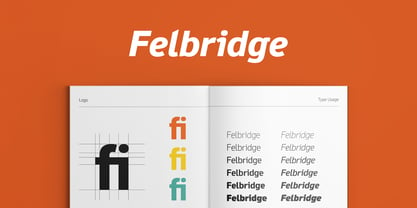Wählen Sie diesen Lizenztyp, wenn Sie eine app für iOS, Android oder Windows Phone entwickeln und Sie die Datei Font in den Code Ihrer mobilen Anwendung einbetten.
Felbridge™
von Monotype
- Aa Glyphen
-
Bestes AngebotFamilienpakete
- Einzelschnitte
- Technische Daten
- Lizenzierung
Felbridge Complete Family Pack
12 FontsPer Font:
$26.24
Paket mit 12 Fonts:
$314.99
Über die Schriftfamilie Felbridge
Der Anstoß für Felbridge war sowohl ehrgeizig als auch sehr praktisch: eine ideale Online"-Schrift für den Einsatz auf Webseiten und in elektronischen Medien zu entwickeln. Robin Nicholas, der Designer der Familie, erklärt: "Ich wollte eine geradlinige serifenlose Schrift mit starken, klaren Buchstabenformen, die auch in Umgebungen mit niedriger Auflösung nicht beeinträchtigt werden. Es überrascht nicht, dass das Design auch in traditionellen Druckanwendungen außergewöhnlich gut funktioniert.
Um sein Ziel zu erreichen, passte Nicholas 2001 die inneren Striche komplexer Zeichen wie das M und das W an, um die Ansammlung von Pixeln auf dem Bildschirm zu verhindern und die Lesbarkeit zu verbessern. Zeichen mit runden Strichen wurden mit quadratischen Proportionen gezeichnet, um den Platz auf dem Bildschirm voll auszunutzen. Darüber hinaus wurden Zeichen wie das I, j und l mit kleinen Serifen versehen ( hinzugefügt am ), um sowohl die Lesbarkeit als auch die Lesbarkeit zu verbessern. "Das Ergebnis", so Nicholas, "ist eine leicht humanistisch anmutende Schrift, die sparsam im Gebrauch und hervorragend lesbar ist - selbst bei relativ kleinen Punktgrößen.
Die meisten serifenlosen Schriften haben Kursivbuchstaben, die auf dem einfachen Prinzip der "Sloped Roman" beruhen, aber die Kursivbuchstaben von Felbridge wurden in der Tradition gezeichnet, visuell heller zu sein als ihre Ähnliche Roman Fonts, was einen starken Kontrast bietet, wenn die Kursivbuchstaben zur Betonung in römischem Text verwendet werden. Die kursiven Buchstabenformen haben außerdem eine leicht kalligrafische Note und charakteristische "hakige" Striche, die den Lesefluss verbessern.
Felbridge ist in vier Strichstärken erhältlich - Light, Regular, Bold und Extra Bold - mit ergänzenden Kursivschriften für die Regular- und Bold-Designs. Das Ergebnis ist eine bemerkenswert vielseitige Schriftfamilie, die sich sowohl für Magazintexte als auch für Werbetexte und Produktbranding eignet. Als Branding-Schrift eignet sich Felbridge für alle Umgebungen, von traditionellen Drucksachen bis hin zum Webdesign, und ist sogar für den allgemeinen Bürogebrauch geeignet. Als Teil einer Corporate Identity ist diese schnörkellose Schriftfamilie ein unverwechselbares und effektives Kommunikationsmittel."
Felbridge™. Font Leitfaden einschließlich bewährter Verfahren, Font Paarungen und Alternativen.
Designer: Robin Nicholas
Herausgeber: Monotype
Foundry: Monotype
Eigentümer des Designs: Monotype
MyFonts Debüt: Oktober 13, 2005

Über Monotype
Die Monotype Library ist eine der weltweit größten und umfangreichsten Schriftensammlungen, die sowohl historisch bedeutsame Originaldesigns als auch ein frisches Angebot an zeitgenössischen und modischen Fonts enthält. Die Monotype Library umfasst Tausende von zeitlosen Klassikern, handgefertigten Wiederbelebungen und Originaldesigns von vielen der innovativsten Schriften Designer und Foundrys der Geschichte. Diese unverwechselbare, preisgekrönte Bibliothek von Premium Fonts bietet Marken und Designer eine breite und zuverlässige Auswahl an Schriften für ausdrucksstarke Typografie im Druck und auf dem Bildschirm. Die Seite Premium Foundry kann hier eingesehen werden.
Mehr lesen
Weniger lesen